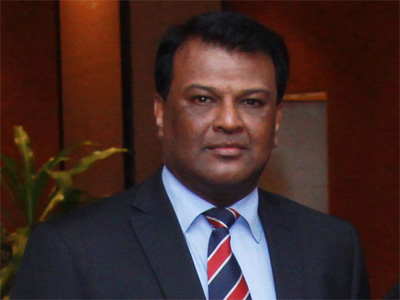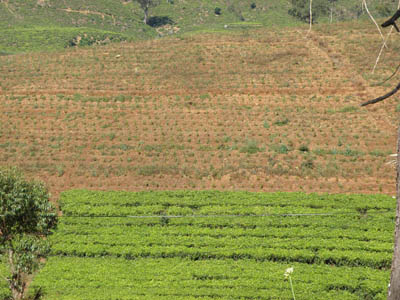Chairman Planters’ Association envisions a different cup of tea
 Tea is a global commodity. As the largest agrarian industry in Sri Lanka providing direct and indirect employment to more than two million people or nearly 10% of the population, it has contributed greatly towards rural development and urbanization of remote hilly areas by optimum use of land and uplifting of social indicators among communities. Tea is a global commodity. As the largest agrarian industry in Sri Lanka providing direct and indirect employment to more than two million people or nearly 10% of the population, it has contributed greatly towards rural development and urbanization of remote hilly areas by optimum use of land and uplifting of social indicators among communities.
Sri Lanka’s tea export earnings were Rs.160 billion in the year 2012 and Rs.197bln in 2013 making these the highest ever. However, negative reports continue to place the industry in crisis. Roshan Rajadurai, Chairman, Planters’ Association of Ceylon (PA) says“It is challenging, a battle due to global competition, adverse climates and costs, including labour. In an agricultural economy, any industry is very dependent on external factors, so it is always challenging, but not a crisis.”
Sitting on the laurels of last year’s record earnings will not serve the future of the industry. Critical issues of replanting, rising cost of production through systematic wage increases, labour shortages, climate changes, role of the smallholder and the outgrower model, diversification, collective stakeholder involvement, training and research and development are all areas where making incremental changes is not enough, the need for significant shifts are vital.
Replanting and Infilling
 One of the fundamental reasons for low yields has been the senility of tea bushes, some of which are nearly one hundred years old. “Replanting is very labour and capital intensive - one hectare being replanted costs Rs.3.9 million. Furthermore it will take 20 years to cover the initial investment,” states Rajadurai. One of the fundamental reasons for low yields has been the senility of tea bushes, some of which are nearly one hundred years old. “Replanting is very labour and capital intensive - one hectare being replanted costs Rs.3.9 million. Furthermore it will take 20 years to cover the initial investment,” states Rajadurai.
As a solution for both inadequate manpower and financial resources, the Budget Proposals 2013 provided a tea replanting subsidy up to Rs.350,000 per hectare and increased new planting subsidy up to Rs.250,000 per hectare. According to Rajadurai, “Replanting is a national issue. The Government has taken special note of this and given the assurance to make long term funding available on concessionary rates.”
Regional Plantation Companies (RPCs) and Smallholders too are involved in the replanting effort with RPCs having planted one third of the existing vegetation in terms of new clearings. The Ministry of Plantation Industries Progress Report 2013 states during January to August alone ‘Land preparation of 519 hectares under tea replanting has been completed and soil rehabilitation in 582 hectares was undertaken and 457 hectares have been replanted with tea. Tea new planting in 261 hectares has been initiated and planting has been completed in 126 hectares.’
Labour
Tea is a labour Intensive Industry which brings a high wage cost commanded by a strong labour union. Availability of labour in future will be low due to the difficulty of retaining the next generation of workers due to changing of lifestyles.
“We have a serious issue of dwindling labour. Aspirations and dreams are not towards manual work. The free education system, improved roads and telecommunications is creating more awareness among the youth about life beyond agricultural work,” says Rajadurai.
More than 65% of the cost of tea production consists of labour, of which wages are set through legitimate national or regional processes taking note of national poverty lines and minimum wage rates.
In addition, RPCs provide a range of other social and welfare benefits, many of which would be the state’s responsibility in other countries or industries.
“We have taken steps to improve the dignity of labour, by providing them with Personal Protective Equipment (PPE) education, skills and entrepreneurial systems creating opportunities for employment.”
“The biggest plus points for us is the positive life indicators which have improved since privatisation. As an employer, we have to look after others. It is challenging,”said Rajadurai.
Mechanization
Harvesting is the most expensive of all the agricultural operations in tea production and presents a very delicate balance, aimed at maximum production of shoots, without impairing the health of the bush. Sri Lanka’s Tea Research Institute opines “The plantation sector is already facing a major shortage of labour, which affects the productivity and quality of the end product. In view of this, it has become a matter of utmost importance to mechanize the major field operations in tea cultivation”
OutgrowerModel
The debate of low productivity has been dogging the industry for years. One of the solutions mooted is developing out-grower model opportunities as a viable alternative. Under this prototype estate land is allocated to workers who own the crop and the estate provides the services and inputs such as fertiliser and other technical expertise. To ensure quality of the plucked tea leaves, the RPC extends its standard estate supervision to the out grower plots. The employees take care of the tea bushes and harvest the tea leaves, for which they are paid according to a standard, transparent formula.
“Outgrower model means the land is estate-owned, but the crop belongs to the workers,” says Rajadurai.“This model is very successful. The unviability of the current wage model is another factor why the outgrower model should be looked at. The outgrower model is successful, because it is a supplementary source of income and entrepreneurial type of work,”he added.
Stakeholder Participation
Timely involvement of all stakeholders is vital to spur the momentum of the tea industry. “It is time for the Unions to think of sustainability of the plantation industry seriously. 1.2 million people depend on industry. Unless they work together, the impact will be on them. If the industry collapses, it will be the workers and their families who will be the most affected.” Rajadurai cautions.
The Government, regional plantation companies, trade unions and workers must play a collective role. “The Unions, Government and Smallholders must realise how many people are involved in this industry, and that the adverse impact of any downturn would result in huge social problems for them.”
Diversification
Crop diversification is an option available to sustain and improve the productivity of lands. The need to diversify is a “Hot topic” says Rajadurai. Diversifying into other crops such as oil palm and cinnamon has begun. Palm oil is seen as a viable strategy for sustainable growth, aids the production of bio fuel and edible oil.
Most companies have started diversifying into other area as such as tea tourism, energy etc.
From a long-term policy perspective it is imperative to highlight the need for management efforts focused on maximizing net income per unit area through integrated farm management and crop diversification approaches.
Research and Training
“Training, Research and Development is very important. Considering the huge workforce, we are doing training at a moderate level” said Rajadurai.
“Training of plantation executives inculcating greater business and technical skills, Reward Schemes and changing of mindset are also required to meet the changing environment,” concluded Rajadurai.
Released in April 2014
|